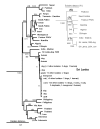Rabies in Sri Lanka: splendid isolation
- PMID: 12643834
- PMCID: PMC2958551
- DOI: 10.3201/eid0903.020545
Rabies in Sri Lanka: splendid isolation
Abstract
Rabies virus exists in dogs on Sri Lanka as a single, minimally divergent lineage only distantly related to other rabies virus lineages in Asia. Stable, geographically isolated virus populations are susceptible to local extinction. A fully implemented rabies-control campaign could make Sri Lanka the first Asian country in >30 years to become free of rabies virus.
Figures


References
-
- Rabies A. Wkly Epidemiol Rec. 2001;76:320–3. - PubMed
-
- Wimalaratne O. Rabies in humans and animals in Sri Lanka. In: Dodet B, Meslin F-X, editors. Rabies control in Asia. Paris: John Libbey Eurotext; 2001. p. 248–51.
-
- Arai YT, Takahashi H, Kameoka Y, Shiino T, Wimalaratne O, Lodmell DL. Characterization of Sri Lanka rabies virus isolates using nucleotide sequence analysis of nucleoprotein gene. Acta Virol. 2001;45:327–33. - PubMed
MeSH terms
Associated data
- Actions
- Actions
LinkOut - more resources
Full Text Sources
Medical
